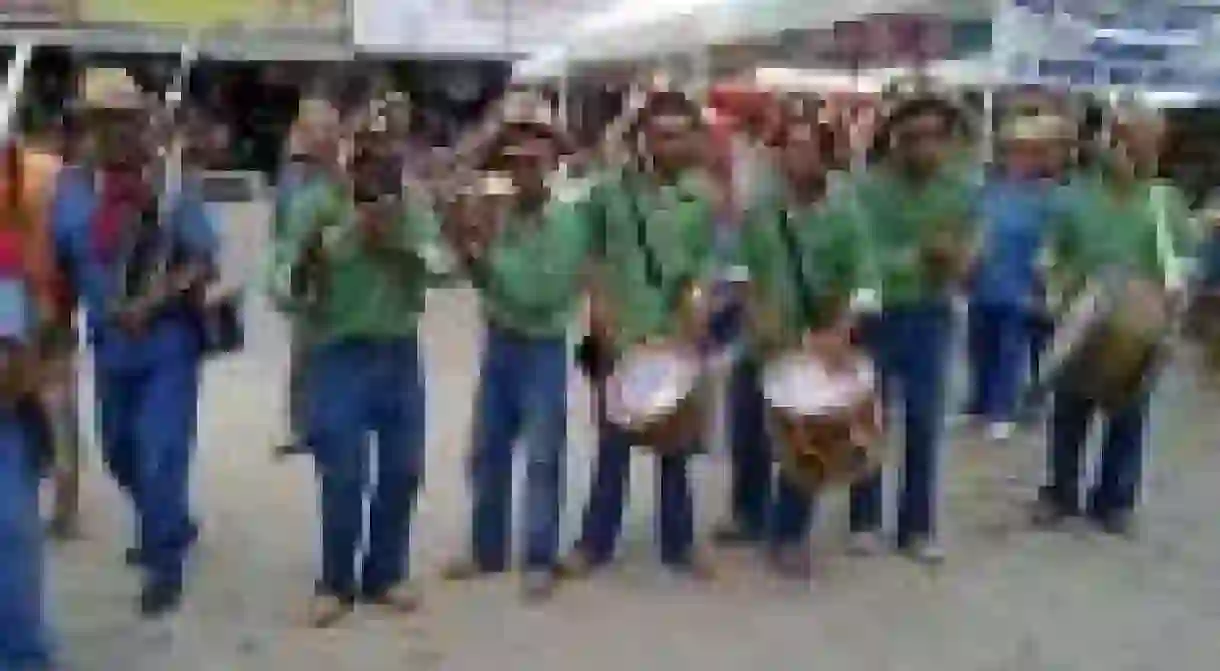Brazil’s Caruaru: The Capital City Of Forró Music

Northeastern Brazil is one of the country’s most culturally rich areas and the cradle of many national myths and folk practices. From its forested coast to the lunar landscape of its hinterland, many musicians and artists have drawn inspiration from its culture to accomplish important works of Brazilian art. Caruaru, a small, town located in the area, has a history intertwined with the most famous of northeastern music genres – the forró.

Caruaru started off in the 18th century as a stopover point for cattle merchants from inland Nordeste on their way to the port city of Recife, where they could export their produce. A powerful landowning family, the Nunes dos Bezerros, built a chapel dedicated to the Virgin Mary. It became a focal point for pilgrimages and fairs, with people gradually settling around it, laying the foundation for the current city. These settlers, reflecting the makeup of the Nordeste, were descendants of indigenous peoples, African slaves and European colonists and immigrants, mostly Portuguese and Dutch. These different influences marked the culture of Caruaru and the Nordeste, shaped by strong religious traditions and the hardship of daily rural life.
This can be observed in the music and dance genres that over the past centuries became identified with the Nordeste and especially with Caruaru. Forró is the umbrella term that covers a variety of different subgenres like baião, quadrilha, xaxado or xote, all having in common the same basic instruments: accordion, triangle, guitar and percussion. Luiz Gonzaga (1912-1989) is perhaps the best-known composer of the genre and to this day there is a museum dedicated to him in Caruaru, the Museu do Forró Luiz Gonzaga, where visitors can learn more about his life and works.
Gonzaga represents the old school of forró, frequently using his songs for social criticism and commentary on the hardships of life in the Nordeste. Born in the town of Exu, Gonzaga ran away form his home at a young age after a quarrel with his father Januário over a love affair of which his family did not approve. He became a soldier, meeting other musicians in the army and returned only after many years as an already successful performer. Gonzaga tells this story in the famous song ‘Respeita Januário’.
One of the most popular contemporary composers of forró is Caruaru-born Petrúcio Amorim, a legend of the city who is active to this day. His lyrics tend to be more romantic, but the same preoccupations of Gonzaga with social justice are also present in Amorim’s compositions. He sings his own works but has also collaborated with other performers working in other genres of Brazilian music, notably Elba Ramalho and Fáfá de Belém. His best known work is perhaps ‘Filho do Dono’, a track which subverts the traditional Brazilian saying ‘I don’t own the world but I’m a son of the owner’ by suggesting that the children of God should take responsibility in improving his creation.
Onildo Almeida is another famous composer and performer born in Caruaru. He is the author of what arguably is the most recognisable forró piece celebrating Caruaru and its traditions, ‘A Feira de Caruaru’, released in an eponymous album in 1957, in collaboration with Gonzaga. The song describes a large open-air market in Caruaru, open daily and gathering musicians, artists and stalls selling food, cattle and craftworks. It is a microcosm of the Nordeste and has been considered by the Brazilian government as protected cultural heritage of the country.
An event not to be missed in the forró calendar in Caruaru is the month-long Festas Juninas dedicated to Saint John and taking place in June. This is the defining event of the Northeast in general and Caruaru in particular, evoking to Brazilians images of midsummer bonfires, all-night dances and small hot-air balloons that are released by the thousands into the night, illuminating the sky with their shining flames. The origins of this festival are a blend of Portuguese catholic traditions, Northern European pagan rituals, and native Brazilian celebrations. Caruaru regularly receives more that a million visitors during this period, from all over Brazil and abroad, eager to experience the epitome of Nordeste culture.
Contemporary Caruaru lives up to its past, keeping alive its history and culture together with its vibrant forró scene throughout the year. At any time, the neighbourhood where most is happening is the Alto do Moura, a district slightly off downtown which is studded with crafts workshops, mainly concerned with clay statues and pottery. Here one can visit the Casa Museu Mestre Vitalino, the former atelier of Mestre Vitorino, the doyen of Caruaru clay artistry, some of whose works are to this day on display at the Louvre. Alto do Moura is also famous for its bars and restaurants. One of these is Bode Assado do Luciano, the most celebrated restaurant in town for the typical Nordeste cuisine it serves. Its specialty is goat meat, served in a variety of ways. Live music in the evenings keeps a lively atmosphere.

Unlike most Brazilian cities, Caruaru’s city centre combines offices and government buildings with other residential quarters and other venues. The city memorial is one of these, a small museum of the history of Caruaru, from pre-colonial times to the present day. It is situated very close to the Feira de Caruaru, inside which can be found the Casa de Cultura José Condé, a museum dedicated to author and novelist José Condé, Caruaru’s most celebrated writer. His stories mix the whimsical with the tragic, taking a passionate yet cynical view of the lives of people from his native city and region. Its location in the grounds of the market is but one of the many charms of the feira, which remains by and large the best place to experience the Nordeste and to understand why Caruaru is known as the capital of forró.













